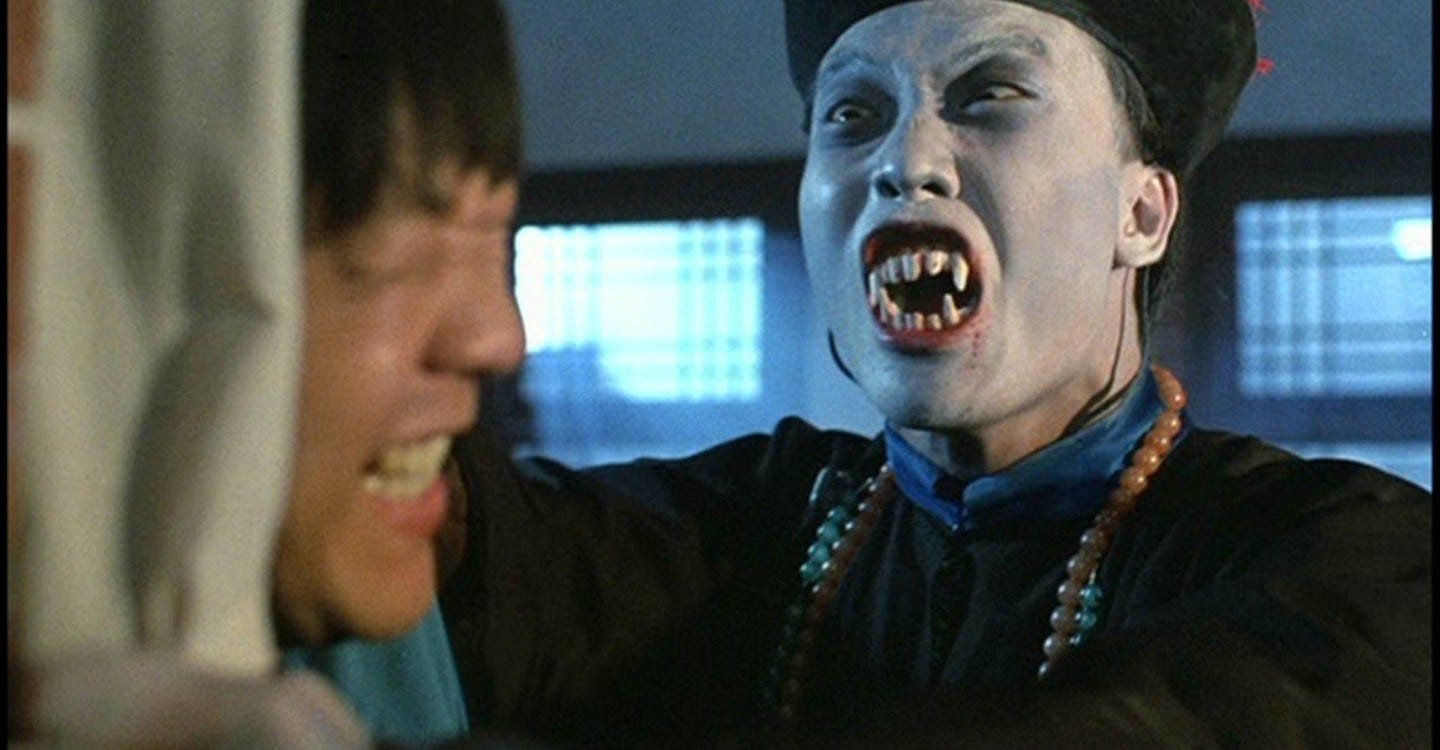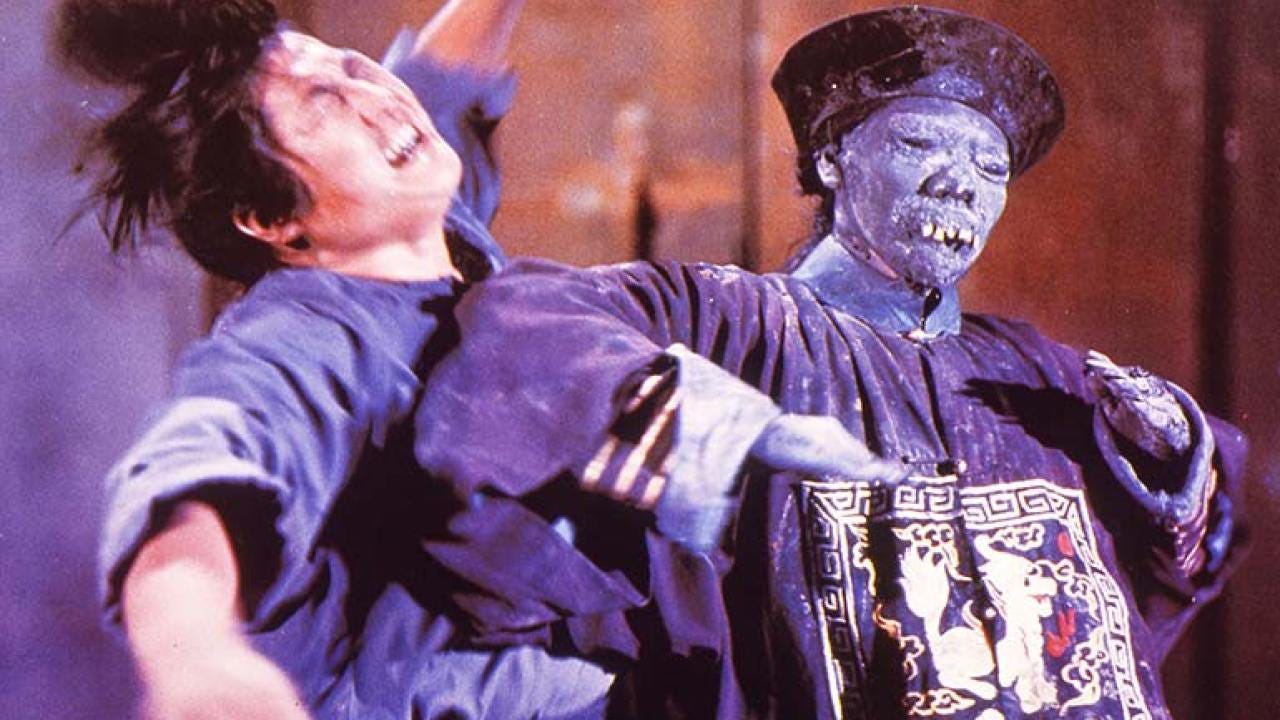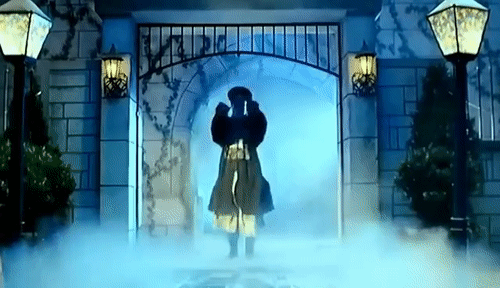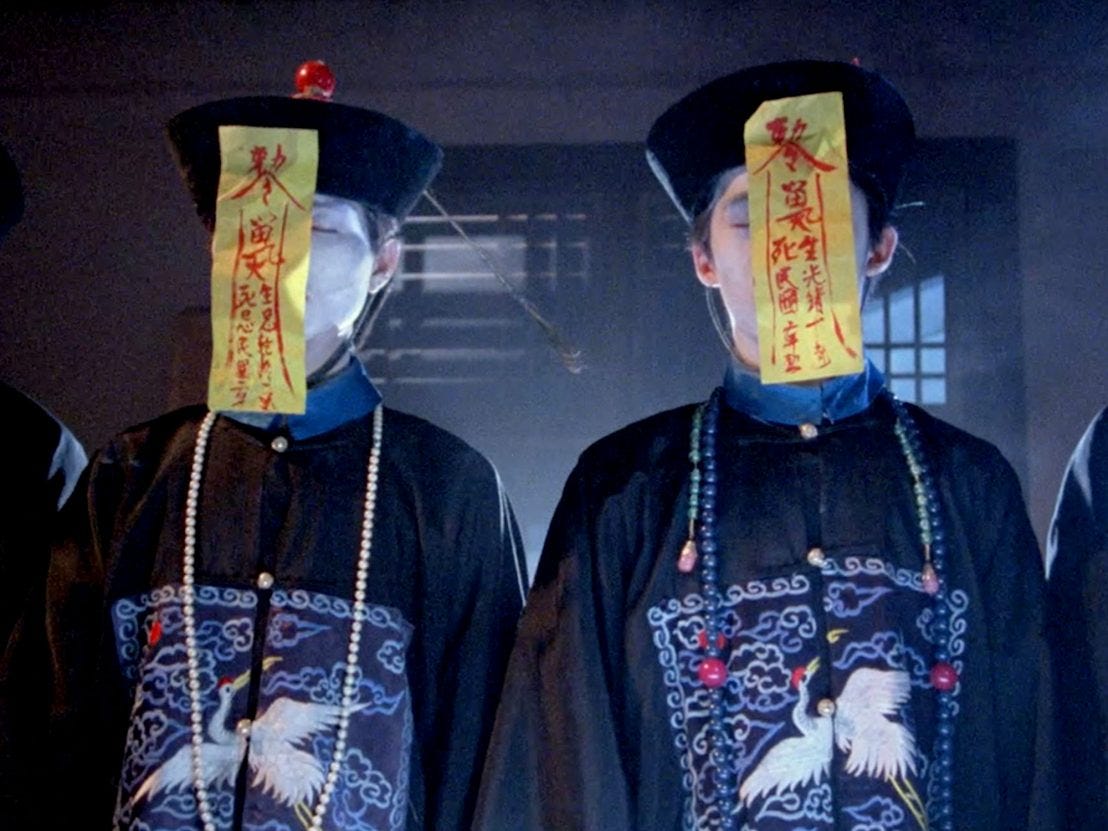In Praise of Hopping Vampires
Scary? Sort of. Funny? Very. Awesome? 100%. It's time to celebrate the undead that hopped their way through the movies of 1980s Hong Kong
At the dawn of the 1980s, Sammo Hung surveyed the cinematic landscape and surmised what it needed: vampires that hop. Working with co-writer Huang Ying, Hung directed and starred in the 1980 film Encounters of the Spooky Kind, a supernatural comedy that introduced movie audiences to jiangshi, hopping undead creatures that had existed in Chinese folklore for centuries but could easily have been invented just for Hung’s use. They were scary when they had to be scary, funny when they had to be funny, and they could hold their own in any martial arts throwdown. They were exactly what Hung needed them to be, but also what Hong Kong moviegoers wanted to see—even if they didn’t know it yet.
Set in the indeterminate past, Encounters of the Spooky Kind (a.k.a. Spooky Encounters) stars Hung as Bold Cheung, a lowly rickshaw driver with some challenging problems. His boss, a Taoist priest named Master Tam (Huang Ha), is having a secret affair with Cheung’s wife (Leung Suet-mei). What’s worse, or at least potentially more deadly, Cheung’s friends like to play supernatural-themed pranks, goading him into spending time in a haunted house then dressing up as ghosts and scaring him—which would be harmless enough if they didn't summon real ghosts in the process. When Master Tam learns Cheung has become suspicious and decides to kill him, Cheung’s problems get even worse: Master Tam’s abilities include the ability to control the jiangshi, whose innate ridiculousness doesn’t make them any less deadly.
The Reveal is a reader-supported newsletter dedicated to bringing you great essays, reviews and conversation about movies (and a little TV). While both free and paid subscriptions are available, please consider a paid subscription to support our long-term sustainability.
That’s the streamlined description of the film’s plot, which also features witches, a spirit with an enormous tongue, a rival priest, and a chatty tofu salesman. Despite a seeming overabundance of disparate elements, it’s an inventive and stylishly realized film. Like the best Hong Kong directors, Hung knows how to push a modest budget as far as it will go, making creative use of moody lighting and letting his flair for action choreography serve as his best special effect. It also features a quintessential Hung performance. Self-deprecating about his generous proportions—the film opens with a dream sequence in which some ghosts call Cheung “fatty”—Hung is happy to play the lumbering buffoon, and so good at it that his acrobatic grace comes as a surprise no matter how many Hung films you’ve seen. (And there are many, even for American audiences that know him best for his time starring on the CBS procedural Martial Law.) The film’s combination of horror, comedy, and action—which helped create an appetite for the supernatural in ’80s Hong Kong cinema—would make it tremendous fun (as long as you look past some sexist attitudes and look away when Master Tam slaughters a live chicken as part of a ritual) even if it didn’t feature hopping vampires.
But it does feature hopping vampires. Rotting corpses in traditional changshan dress, they appear terrifying yet comic as they hop around with outstretched arms, then freeze in place the moment anyone places a paper talisman on their forehead, allowing those in the know to control them. (There are other rules, too, though they sometimes seem to change from scene to scene.) They’re also adept, if stiff (literally and figuratively) martial arts opponents, capable of dishing out real harm. To intensify the film’s mix of the uncanny, the threatening, and the silly, Hung uses an echoing thud to soundtrack their footfalls. Laugh all you want, but it would be a mistake to get in their way.
If moviegoers remembered nothing else about Encounters of the Spooky Kind, they remembered the jiangshi. However deep its roots in Chinese folklore and literature, the jiangshi were essentially a new idea when they came to the movies, a powerful concept destined to return for an encore (then another and another). Where Encounter of the Spooky Kind opened the door for the jiangshi, the 1985 film Mr. Vampire let them hop through that door by the dozens.
In Daniel O’Brien’s Spooky Encounters: A Gwailo's Guide to Hong Kong Horror, he reports that though Mr. Vampire’s inspiration came from stories Hung heard from his actress mother as a child, Hung chose to step back into the role of a producer and let protege Ricky Lau direct. Lau preserves the mix of comedy, action, and scares, sometimes improving on it. Set in the early 20th century, Mr. Vampire stars Ricky Hui as Man-choi, student to the Taoist priest Master Kau (Lam Ching-ying) as they both struggle to fit into a China increasingly influenced by the West. (An inspired comic sequence finds both struggling to make their way through a gathering for “Western tea,” even though they don’t know what they’re doing.)
It’s filled with ghouls and lovelorn ghosts but, despite its title, Mr. Vampire only uses jiangshi in the sequences bookending the film. (And don’t go looking for a character named “Mr. Vampire.” You won’t find one.) That doesn’t stop the hopping vampires from making a strong impression, however, especially in a raucous finale that makes clever use of a newly introduced wrinkle in the jiangshi mythos: no matter how close they get to their would-be victims, they can’t “see” them if they hold their breath. (Did Spielberg file this scene away and draw on it for the T-Rex sequence in Jurassic Park? I like to think so.)
The only problem with new ideas: they don’t stay new forever. Mr. Vampire was followed by Mr. Vampire 2, Mr. Vampire 3, Mr. Vampire 4, and Mr. Vampire 1992. The lattermost, starring Hui and directed by Lau, is the only true sequel. Lau also directed the 1990 film Encounters of the Spooky Kind II. I haven’t seen these films and can’t speak to their quality, though the general consensus is one of diminishing returns. I also haven’t seen the English- language remake starring Michelle Phillips (yes, of the Mamas and the Papas) because it was abandoned mid-production. Nor have I played the video game spin-off released as Phantom Fighter in the United States to an audience that had no clue about its inspiration.
Movies tend to operate in boom-to-bust cycles, a process sometimes accelerated by the seemingly deathless pace of the Hong Kong film industry at its height. In the second half of the ’80s, audiences had all the jiangshi and jiangshi-like entertainment they could stomach and then some. Which raises a question: jiangshi survive not by sucking blood but by draining the life force, or qi, from their victims. Must movies do the same? Is any once-fresh idea—be it superheroes, charismatic car thieves, or deathless John Carpenter-created slasher killers—doomed to desiccation, to hop around searching for the faintest sign of life for eternity, waiting for the next idea to sweep them away and begin the cycle anew? Sometimes it’s best to forget the busts and remember the booms. And the bouncing.
Both Encounters of the Spooky Kind and Mr. Vampire are kind of hard to find in North America at the moment., where fans of Hong Kong cinema have long had to contend with obscure or gray market distributors. Neither title is streaming, but the UK label Eureka has issued some nice, features-packed Blu-rays of the films. They’re Region 2 titles, however, so watching them requires purchasing a region-free player and buying the discs at import costs (a recommended but pricey option).








PS I don’t think gifs work here but if you click on the vampire in the archway you won’t be disappointed.
These not being available to watch is a travesty.